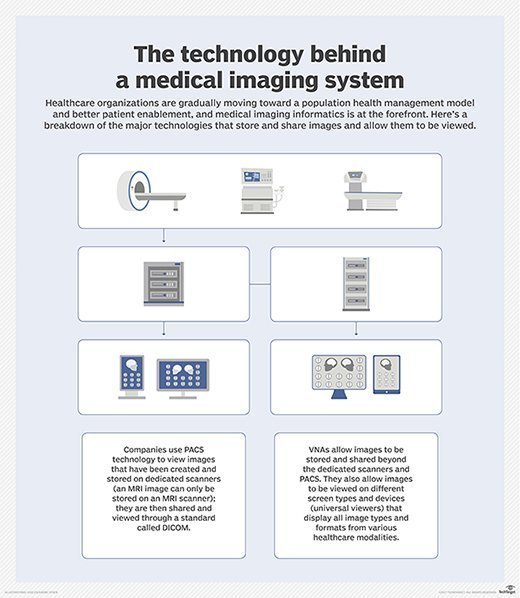DICOM (Digital Imaging and Communications in Medicine)
DICOM (Digital Imaging and Communications in Medicine) is a standard protocol for the management and transmission of medical images and related data and is used in many healthcare facilities.
DICOM was originally developed by the National Electrical Manufacturers Association (NEMA) and the American College of Radiology (ACR). It is a registered trademark of NEMA and is governed by the DICOM Standards Committee, a collaboration of users across all medical imaging specialties with an interest in the standardization of medical imaging information.
What is DICOM used for
DICOM is the international standard to communicate and manage medical images and data. Its mission is to ensure the interoperability of systems used to produce, store, share, display, send, query, process, retrieve and print medical images, as well as to manage related workflows.
Vendors who manufacture imaging equipment -- e.g., MRIs -- imaging information systems -- e.g., PACS -- and related equipment often observe DICOM standards, according to NEMA.
These standards can apply to any field of medicine where medical imaging technology is predominately used, such as radiology, cardiology, oncology, obstetrics and dentistry.
Medical imaging is typically a noninvasive process of creating a visual representation of the interior of a patient, which is otherwise hidden beneath the skin, muscle, and surrounding organ systems, for diagnostic purposes. The term noninvasive in this context means instruments are not introduced into the patient's body -- in most cases -- when performing a scan.
Medical images are used for clinical analysis, diagnosis and treatment as part of a patient's care plan. The information collected can be used to identify any anatomical and physiological abnormalities, chart the progress of treatment, and provide clinicians with a database of normal patient scans for later reference.
Imaging information systems, in compliance with DICOM, have largely eliminated the need for film-based images and the physical storage of these items. Instead, these days, medical images, as well as related non-image data, can be securely stored digitally, whether on premises or in the cloud.
Why DICOM is important
With the introduction of advanced imaging technologies, such as CT scans, and the growing use of computing in clinical work, ACR and NEMA saw a need for a standard method to transfer images and associated information between different vendor devices, according to the International Organization for Standardization. These devices produce a variety of digital image formats.

In 1983, the ACR and NEMA formed a joint committee in hopes of developing standards with the goal of promoting communication of digital imaging information, regardless of the device manufacturer, and to facilitate the development and expansion of PACS.
Today, DICOM is used worldwide to store, exchange and transmit medical images, enabling the integration of medical imaging devices from multiple manufacturers. Patient data and related images are exchanged and stored in a standardized format. Without a standards-based approach, it would be difficult to share data between different imaging devices because they would need to interpret multiple image formats.
With DICOM, physicians have easier access to images and reports, allowing them to make a diagnosis, potentially from anywhere in the world. In turn, patients obtain more efficient care.
Not all medical images follow a DICOM format, which has led to the development of cross-document sharing, or XDS. An extension known as XDS-I is specific to imaging and allows the storage of multiple image formats. Many medical imaging system vendors offer features that interpret DICOM and non-DICOM formats.
The DICOM standard
The DICOM Standard is an ever-evolving outline of digital imaging management standards. DICOM provides a multipart document that details the history, scope, goals and structure of the standard. This information is available online in various file formats and is revised and republished regularly.
As of this publishing, there are 21 separate parts covering everything from DICOM's overview, definitions, data structures and encoding, media storage, media formats, security, and other important aspects of DICOM's standardization and protocols.






